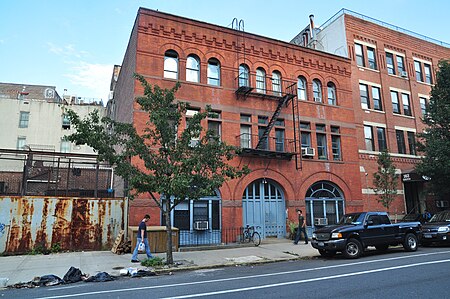Feuchtwanger Stable
Agricultural buildings and structures on the National Register of Historic PlacesAgricultural buildings and structures on the National Register of Historic Places in New York (state)Brooklyn Registered Historic Place stubsBrooklyn building and structure stubsBuildings and structures in Brooklyn ... and 6 more
Buildings and structures on the National Register of Historic Places in New York CityFort Greene, BrooklynInfrastructure completed in 1888National Register of Historic Places in BrooklynRomanesque Revival architecture in New York CityStables in the United States

Feuchtwanger Stable is a historic stable building located in Fort Greene, Brooklyn, New York, New York. It was built in 1888 in the Romanesque Revival style. It is a three-story brick structure trimmed with stone and terra cotta. The first floor features three wide, round arches that once served as entrances for horses. The building has housed a candy factory, a storage warehouse, and an auto repair garage. It was converted into loft condominiums in 1988.It was listed on the National Register of Historic Places in 1986.
Excerpt from the Wikipedia article Feuchtwanger Stable (License: CC BY-SA 3.0, Authors, Images).Feuchtwanger Stable
Carlton Avenue, New York Brooklyn
Geographical coordinates (GPS) Address Nearby Places Show on map
Geographical coordinates (GPS)
| Latitude | Longitude |
|---|---|
| N 40.692777777778 ° | E -73.9725 ° |
Address
Carlton Avenue 159
11205 New York, Brooklyn
New York, United States
Open on Google Maps





